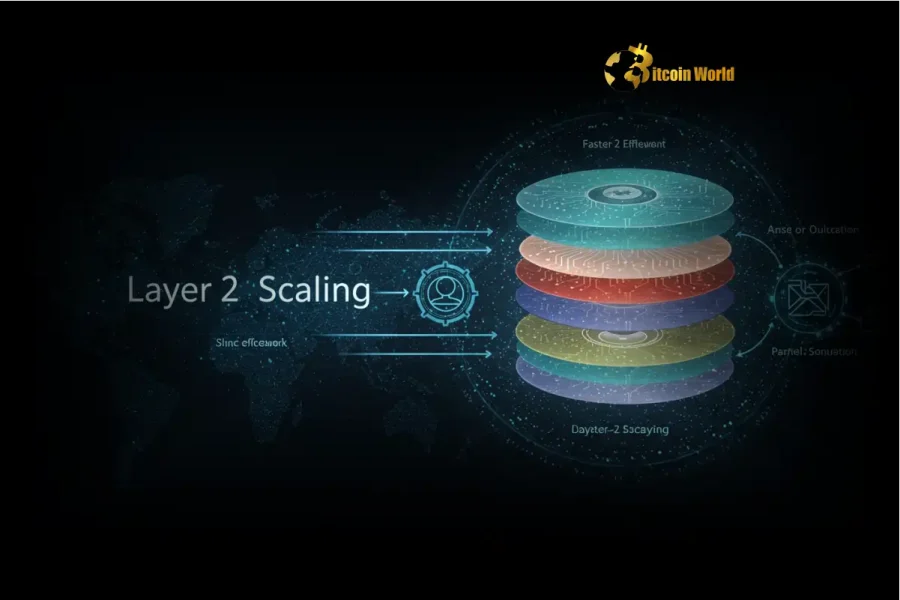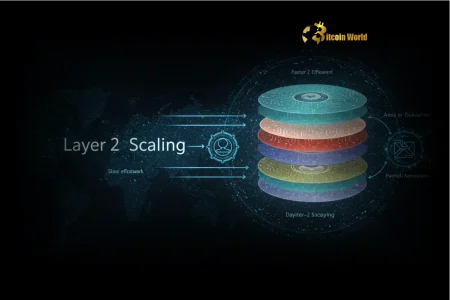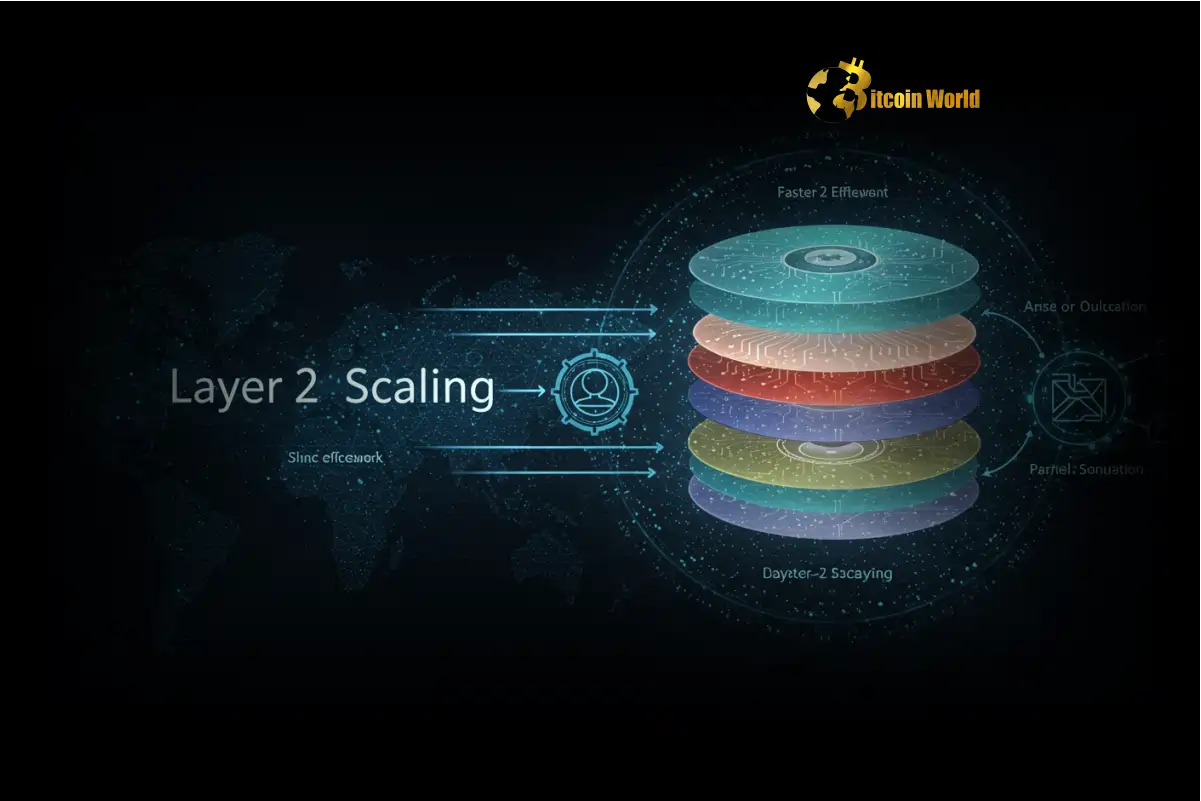Ethereum Layer 2 Scaling: Unlocking Astonishing Crypto Speed
0
0


BitcoinWorld

Ethereum Layer 2 Scaling: Unlocking Astonishing Crypto Speed
Are you tired of high gas fees and slow transaction times on the Ethereum network? You’re not alone! This is where Ethereum Layer 2 scaling solutions come into play, revolutionizing how we interact with decentralized applications and driving significant advancements in Crypto Scaling.
Understanding the Need for Ethereum Layer 2
Ethereum, the backbone of countless decentralized applications (dApps), NFTs, and DeFi protocols, faces a significant challenge: scalability. As network usage grows, so do congestion and transaction costs, making it expensive and slow for everyday use. This limitation is precisely what Layer 2 Solutions aim to address, building on top of the existing Ethereum blockchain to handle transactions off-chain while inheriting its robust security.
Think of it like this: Ethereum is a bustling city’s main highway, but it gets jammed during rush hour. Layer 2 solutions are like building express lanes or parallel routes that handle most of the traffic, leaving the main highway (Layer 1) for settlement and security.
How Do Layer 2 Solutions Boost Crypto Scaling?
Layer 2 Solutions employ various techniques to process transactions faster and cheaper than directly on the Ethereum mainnet (Layer 1). The core idea is to move the bulk of computation and data storage off-chain, only using Layer 1 for crucial functions like settlement and data availability.
Key approaches include:
- Rollups (Optimistic and Zk-Rollups): These bundle hundreds or thousands of transactions into a single batch. This batch is then executed off-chain, and only a small amount of data representing the batch’s state change is posted back to Layer 1. Optimistic Rollups assume transactions are valid by default and use fraud proofs, while Zk-Rollups use cryptographic validity proofs (zero-knowledge proofs) to instantly verify batch correctness.
- Plasma: This framework creates child chains that periodically report their state roots to the main Ethereum chain. This allows for high transaction throughput off-chain, though exiting funds back to Layer 1 can be more complex.
- State Channels: These allow participants to conduct multiple transactions off-chain within a secure channel, only interacting with the main chain when opening or closing the channel. They are great for specific use cases like payment channels.
Each method contributes significantly to overall Blockchain Scaling by reducing the load on the Ethereum mainnet.
Key Benefits of Ethereum Scalability via Layer 2s
The adoption of Layer 2 technologies brings a multitude of benefits for users, developers, and the entire Ethereum ecosystem:
- Lower Transaction Costs: By processing transactions off-chain in batches, the fixed cost of interacting with Layer 1 is amortized across many users, drastically reducing gas fees per transaction.
- Increased Transaction Speed: Off-chain processing allows for much higher transaction throughput compared to Layer 1’s limits, leading to faster confirmations.
- Enhanced User Experience: Faster, cheaper transactions make dApps more responsive and accessible for everyday activities, fostering wider adoption.
- Innovation: Developers can build more complex and feature-rich applications that wouldn’t be feasible or affordable on Layer 1 alone.
- Improved Ethereum Scalability: Ultimately, Layer 2s are the primary path forward for Ethereum to handle global-scale adoption without compromising decentralization or security.
These benefits are driving the rapid evolution and adoption of Layer 2 Solutions across the crypto landscape.
What Are the Challenges for Layer 2 Solutions?
While promising, the path to mass adoption for Layer 2s isn’t without hurdles:
- Fragmentation: The existence of multiple Layer 2 networks can lead to liquidity fragmentation and challenges in interoperability between different L2s or between L2s and Layer 1.
- Complexity: Understanding and interacting with different Layer 2 solutions can be more complex for average users compared to direct Layer 1 interactions.
- Security Nuances: While inheriting Layer 1 security, each L2 design has its own specific security considerations and potential risks (e.g., reliance on sequencers, withdrawal periods).
- Bridging Assets: Moving assets between Layer 1 and various Layer 2s, or between different Layer 2s, requires bridges, which can introduce points of risk or delay (especially withdrawal periods for Optimistic Rollups).
Addressing these challenges is crucial for seamless Blockchain Scaling.
Popular Ethereum Layer 2 Solutions in Action
Several prominent Layer 2 Solutions are already live and gaining traction, handling significant transaction volume and value. Here are a few examples:
| Solution | Type | Focus/Key Use Cases |
|---|---|---|
| Arbitrum | Optimistic Rollup | General-purpose dApps, DeFi |
| Optimism | Optimistic Rollup | General-purpose dApps, DeFi |
| zkSync | ZK-Rollup | Payments, DeFi, NFTs, general dApps |
| StarkNet | ZK-Rollup (Validium/Volition) | General-purpose dApps, high-throughput applications |
These platforms are actively contributing to solving the Ethereum Scalability problem and driving innovation in the space.
Actionable Insights for Navigating Blockchain Scaling
If you’re looking to leverage the power of Ethereum Layer 2 solutions, here are a few tips:
- Research Specific Solutions: Understand the differences between Optimistic and ZK-Rollups, their withdrawal periods, and the dApps available on each network.
- Use Bridges Carefully: When moving assets, use reputable bridges and be aware of the time it might take to withdraw funds back to Layer 1, especially from Optimistic Rollups.
- Explore Ecosystems: Many popular dApps have deployed versions on Layer 2s. Explore these ecosystems to find faster and cheaper ways to interact with your favorite protocols.
- Stay Informed: The Layer 2 landscape is rapidly evolving. Keep up with new developments, security audits, and feature releases.
Embracing Layer 2 is key to experiencing the next phase of crypto interaction.
Summary: The Future is Scaled
Ethereum Layer 2 scaling is not just an upgrade; it’s a fundamental shift in how the network operates, paving the way for mass adoption. By significantly improving Crypto Scaling through reduced costs and increased speeds, Layer 2 Solutions are unlocking new possibilities for decentralized applications and making the Ethereum ecosystem more accessible and user-friendly than ever before. While challenges exist, the rapid development and adoption of these technologies demonstrate a clear path towards achieving robust Ethereum Scalability and advancing the entire field of Blockchain Scaling. The future of decentralized finance, NFTs, and Web3 relies heavily on the continued success and innovation within the Layer 2 space.
To learn more about the latest crypto market trends, explore our article on key developments shaping Ethereum Layer 2 institutional adoption.
This post Ethereum Layer 2 Scaling: Unlocking Astonishing Crypto Speed first appeared on BitcoinWorld and is written by Editorial Team
0
0
 Manage all your crypto, NFT and DeFi from one place
Manage all your crypto, NFT and DeFi from one placeSecurely connect the portfolio you’re using to start.






